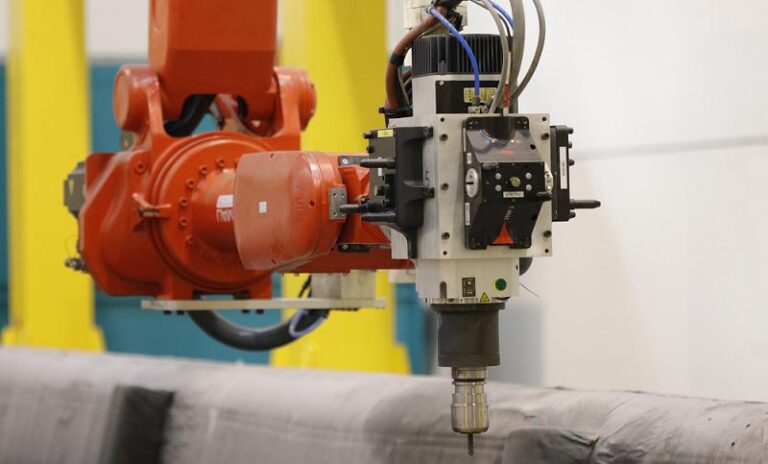There are currently two types of manufacturing – additive, also known as 3D printing, where an item is built by adding material layer by layer, and subtractive, which starts with a piece of material and takes pieces away through processes such as milling and polishing until you’re left with the final product.Now, researchers are building hybrid machines that are able to perform both types of manufacturing at once, and on a scale that brings 3D-printed houses and cars within reach.‘We want to use the best of both technologies,’ said Jose Antonio Dieste, from Spanish technology centre AITIIP. ‘Additive manufacturing has some problems, one is the accuracy for large parts, another is the quality of the finishing. We are trying to complement this additive with subtractive in order to improve the performance.’He runs the EU-funded KRAKEN project, which is designing a ceiling-mounted robotic arm that lays down a thin layer of a material, such as aluminium, then finishes that layer by taking away any unnecessary material, before repeating this process until the product is built.The idea is to accurately construct large components such as side panels for cars, while saving on materials by only using exactly what is required, thus lessening the environmental footprint of industry.Large components‘We are going to work on medium and large components,’ he said. ‘(Now) additive machines are working on quite small parts, half a metre maximum. We are going to be able to build 24-metre-long parts.’New innovations in the nozzles and in the ingredients should also speed up this type of manufacturing, by increasing the deposit rates of the materials, says Dr Dieste.‘Additive 3D printing machines are very slow. In order to build a half-metre part, some of the machines need one to two days. We need to go faster. For example, a five-metre-long (car) should take two or three days maximum.’A prototype of the KRAKEN machine, which will be modelled on a robotic arm developed in a previous project called MEGAROB, should be ready by 2019.It will specifically be designed to build components from metal, particularly aluminium, and resins known as thermosets. However, other researchers are creating hybrid manufacturing machines that can work with other types of materials.“‘In the very long future, perhaps someday we can see a robot printing an entire building.’Jorge Rodriguez Julián, VÍAS, SpainJorge Rodriguez Julián from Spanish construction firmVÍAS, coordinates the EU-funded HINDCON project which is developing a hybrid manufacturing machine that uses concrete to build up components for use in construction. A prototype is planned for 2018.He says this type of manufacturing could be used to build almost every element of a building, from panels and internal walls to roofs, without being constrained by their size.Complex shapesBut, he says, there is no point in using this to build regular, plain walls of fixed dimensions as traditional techniques can already do that efficiently. For him, the biggest potential of this type of manufacturing is creating elements with complex shapes, from the architecture of non-conventional buildings such as museums to bespoke or complicated features within a conventional building.‘When we talk about additive manufacturing in construction, we always say that shape, the form, is for free. Because at the end the machine’s costs are the volume of materials generated and time. While in traditional techniques, it is very expensive.’However, Rodriguez Julián says that additive manufacturing with concrete is currently complex and only used in a limited way. The advantage of a hybrid machine is that it would enable elements to be built faster, more accurately and with a better final appearance, while also reducing the environmental footprint.Subscribe to our newsletterThe HINDCON researchers are also developing new kinds of materials that could enhance the structural properties of what they produce, potentially removing the need to have a steel beam going through a concrete element and opening up new design possibilities.According to Rodriguez Julián, the dimensions of what will eventually be printed won’t be limited by the machine but by the logistics of transporting the structures, leading to the question of whether entire buildings could be printed on site. However, he says that this is a long way off.‘In the very far future, perhaps someday we can see a robot printing an entire building. But … there is a long way until the technology is prepared to do this, and do it in an efficient way.’On Feb 28 the EU is running an EU Industry Day to debate the future of European industry. For more visithttp://ec.europa.eu/growth/tools-databases/newsroom/cf/itemdetail.cfm?item_id=9063The IssueAround EUR 17 billion has been allocated toIndustrial Leadershipunder the EU’s 2014 to 2020 research funding programme Horizon 2020.It covers everything from technology to make factories more competitive to helping finance innovative small- and medium-sized companies.In order to increase the competitiveness of European countries, the EU is calling for national governments to ensure that by 2020 they are spending 3 % of their yearly economic output on research and development.
This article was originally published in Horizon, the EU Research and Innovation magazine.
Add to favorites:
Share:
Listing Description
Video
Documents
No documents available.
Ask KETMarket to make a contact
Connect with the Listing Owner!
💬 Please log in now to askKETMarket to make a contact. Not a member yet? Sign up for free and start connecting today!
Video
Related Funding and Finance Opportunities
Unlock Exclusive Funding Opportunities!
🔑 Get instant access to tailored funding opportunities that perfectly match your needs. This powerful feature is exclusively available to our premium members—helping you save time, stay ahead of the competition, and secure the right funding faster.
Upgrade to Premium now and never miss an important opportunity again! Already a premium member? Log in here to explore your matches.
Related Innovation Offers
Discover Tailored Innovation Offers!
🚀 Gain access to technology solutions that match your specific needs and interests—carefully selected to support your innovation goals. These offers are exclusively available to our premium members, helping you identify relevant technologies faster and start the right conversations with potential partners.
Upgrade to Premium now and explore your personalized technology matches today! Already a premium member? Log in here to view your tailored offers.
Related Knowledgeable Resources
Discover More with Premium: Related Knowledge Resources
🔒 You’re missing out on expert-curated knowledge specifically matched to this topic. As a Premium member, you gain exclusive access to in-depth articles, guides, and insights that help you make smarter decisions, faster.
Whether you’re preparing a funding proposal, researching a new market, or just need reliable information—our Premium knowledge matches save you hours of research and point you directly to what matters.
Upgrade to Premium now and instantly unlock relevant knowledge tailored to your needs! Already a member? Log in here to view your personalized content.

